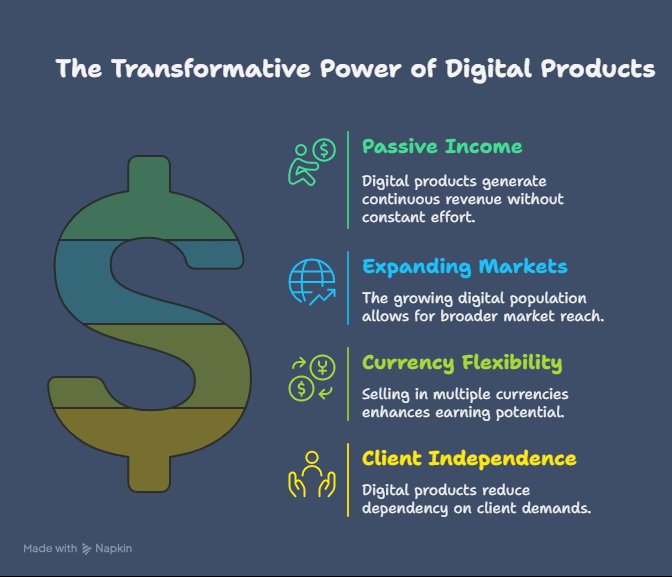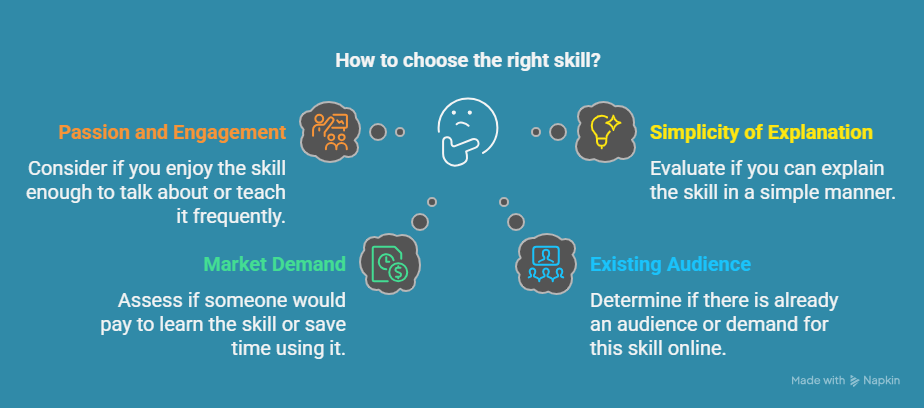What if you could stop chasing clients and start creating something once… that sells over and over again? That’s the power of digital products for African freelancers.
Are you a writer, designer, teacher, voice-over artist, or even the go-to Canva queen in your WhatsApp group? Then guess what? You already have what it takes to build something valuable—and profitable—online!
And no, you don’t need to be a tech wizard or a marketing guru. All you need is your existing skill, a clear step-by-step roadmap (which you’re about to get), and a sprinkle of African creativity.
This guide will walk you through the entire journey from idea to income. We’ll break down:
- What kind of skills can be turned into digital products
- How to pick the right product type
- Free (or super cheap) tools you can use
- How to price, market, and sell your product—without needing a website
No fluff. No complicated jargon. Just real, relatable steps that work for African freelancers like you.
Why Digital Products Are a Game-Changer for African Freelancers
Let’s be honest… freelancing in Africa is not for the faint of heart.
You’ve got clients ghosting, platforms with stiff competition, currency rates playing yo-yo, and bills that just won’t wait. Add to that the rising cost of living and unpredictable job markets, and you start to feel like you’re constantly running uphill with a backpack full of rocks.
But here’s the plot twist: You’re sitting on a goldmine.
Yes, you.

That graphic design skill? Gold.
Your social media know-how? Valuable.
Even your ability to teach complex things in simple ways? That’s a digital product waiting to happen.
Here’s why digital products are a total game-changer:
1. You Create It Once, Sell It Forever
No more hourly chasing. Once you package your knowledge or skill into a product (like a guide, course, template, or ebook), it works for you, even while you sleep. Passive income isn’t just a buzzword. It’s a lifestyle upgrade.
2. High Internet Use = Bigger Markets
Africa’s digital population is exploding. More people are learning online, working remotely, and consuming digital content. You can start by selling to your fellow Africans, then scale globally. The internet doesn’t care about your zip code.
3. You Can Earn in Dollars
With platforms like Gumroad, Selar, and Paystack, you can price your product in USD, GBP, EUR, or even local currency, and reach people worldwide. And let’s not lie, earning in dollars feels like having a superpower in today’s economy.
4. You’re No Longer at the Mercy of Client Moods
No more “Can you lower your price?”
No more “Can you deliver in 2 hours?”
Your digital product becomes a boundary-protected business asset, not just another favor for exposure.
Bottom line? The market is ready. The tools are accessible. And you already have the skill.
Read: Why Now Is the Best Time for African Freelancers to Create Digital Products
Step 1: Identify the Right Skill to Productize
Here’s a truth bomb: You don’t need to learn something new to make money online. You just need to recognize what you already do well and turn it into a product people will pay for.
So… what can you offer?
Maybe you’ve been writing killer CVs for friends.
Or people are always asking you to “help with Canva.”
Or you’ve somehow become the go-to person for social media captions in your circle.
That’s your clue.
You don’t have to be an “expert” with 20 years of experience. You just need to be a few steps ahead of someone else who wants to learn what you already know.
How to Recognize What You’re Good At
Start by asking yourself:
- What do people constantly ask me for help with?
- What task feels easy for me but hard for others?
- Have I taught someone something before that helped them?
- What skill have I used to earn money (even once)?
If people already come to you for help with something, you’re sitting on value. Period.
What Skills Are in Demand (Locally & Globally)?
Here’s some good news: the world is hungry for digital solutions. Some high-potential areas include:
- Graphic design (especially templates
- Copywriting & content writing
- Video editing or voiceovers
- Social media strategy
- Tech tutorials (Canva, Excel, ChatGPT, etc.)
- Language teaching or exam prep
- Relationship advice or career coaching
- Digital planners, ebooks, or Notion templates
- Productivity or business tips
You don’t have to be a unicorn. Just package your experience with a purpose.

Pro Tip: Don’t overthink it. Pick one, and start small. You can always evolve later.
Read: What Skills Can African Freelancers Turn into Profitable Digital Products?
Step 2: Choose a Product Format That Works for You
Alright, so you’ve figured out your skill… amazing. Now comes the fun part: choosing how to package it.
Because not every skill needs to become a 20-module video course. (Please, don’t stress yourself unnecessarily.)
Some skills are better shared through simple guides, some work better with templates, and some need a bit more “face time” through courses or tutorials.
Let’s break it down.
Popular Digital Product Formats for African Freelancers
| Format | Perfect For | Examples | Pros | Cons |
| eBooks & Guides | Writers, coaches, marketers, designers | “How to Grow on Instagram,” “Beginner’s Guide to Graphic Design” | ✅ Easy to create (Google Docs or Canva) ✅ Great for knowledge-sharing ✅ No complex tools needed | ❌ Takes time to write and format ❌ Needs good design to stand out |
| Mini Courses | Tech skills, tutorials, personal development, teachers | “How to Use Canva for Business,” “Freelancing 101” | ✅ Higher perceived value ✅ Personal and engaging ✅ Great for in-depth topics | ❌ Requires video/audio setup ❌ Can be overwhelming for beginners |
| Templates & Tools | Designers, planners, content creators | Instagram templates, CV formats, Notion planners, Excel budget sheets | ✅ Quick to create ✅ Easy to sell repeatedly ✅ People love done-for-you resources | ❌ Needs eye-catching design ❌ Can be copied or shared without permission |
| Memberships/Communities | Coaches, content creators, accountability groups | “Writing Club for Freelancers,” “Social Media Tips Group” | ✅ Recurring income (monthly access) ✅ Builds trust and community ✅ Great for ongoing content | ❌ Requires consistency and engagement ❌ Takes time to grow and manage |
Pro Tip for Beginners:
Start with ONE simple product that solves ONE clear problem.
No need to build Rome or Udemy in a day. Just solve a pain point and keep it moving.
Curious what formats are trending right now?
Read: Best Digital Products for African Creators
Step 3: Validate Your Product Before You Build
Here’s something a lot of first-time creators skip… and regret later:
Don’t spend weeks creating a product nobody asked for. It’s like cooking jollof rice for a party… only to find out everyone wanted fufu. Painful.
Validation simply means: “Is there enough interest in this idea to make it worth my time?” And no, you don’t need a fancy marketing degree to figure this out.
Why You Must Validate Before Building
- It saves you time and frustration
- It helps you refine your idea into something people actually want
- You might even get your first customers before you finish creating the product
That’s the smart way to work — build what’s already in demand.
Quick and Simple Validation Techniques
Here are a few easy ways to test your idea before going all in:
1. Ask Your People
- Post on WhatsApp status, Facebook, or in a relevant group:
“If I made a guide on how to land your first freelance client in 30 days, would you be interested?” - Watch how people respond. If they say yes or start asking questions, you’re onto something.
2. Create a Waiting List
- Use a free tool like Google Forms or Mailchimp to collect emails
- Share the link with this message:
“I’m creating a toolkit to help you design Instagram graphics in 15 minutes. Want early access?” - If people sign up, you’ve got validation.
3. Sell Before You Build (a.k.a. The Pre-Sale Method)
- Create a landing page or post with your product description and price
- Offer a discounted rate for early birds
- If people buy or express serious interest… boom, green light!
4. Search for Similar Products
- If others are already selling something similar, that’s a GOOD sign
- It means people are willing to pay for this kind of solution (Just make sure yours has your unique twist!)
A Gentle Reminder:
Now remember, you’re not trying to be the next Mark Zuckerberg just yet. You’re simply checking if your idea has enough “spark” to become profitable.
Read: How to Know if Your Digital Product Will Sell
Step 4: Create Your First Digital Product (Without Tech Overload)
Now that you’ve validated your idea, it’s time to actually build the thing. But before you start panicking about software and tech stuff… breathe.

You don’t need a ring light, green screen, or Silicon Valley budget. You just need your brain, your skill, and a few tools that won’t eat up your data or your sanity.
Simple Tools That Work on Low Bandwidth
We know the hustle. You might be working with spotty Wi-Fi, shared mobile data, or even in a noisy cybercafé. That’s why these tools were selected with the African context in mind:
| Tool | Use | Why It’s Great |
| Canva (Free & Pro) | Design eBooks, templates, promo graphics | Easy to use, even on mobile; great for visual content |
| Google Docs/Slides | Write and format eBooks or presentation-style courses | Autosaves your work, works offline, easy to share |
| Zoom or Loom | Record video tutorials | No need for fancy editing; just hit record and teach |
| Audacity (Free) | Record and edit audio for voice-over content | Lightweight, open-source, perfect for audio lessons |
| Notion / Trello | Organize your content plan | Helps you stay sane when managing chapters, modules, or lessons |
| Paystack/Flutterwave | Accept payments | Easy to set up for African creators and accepts local currencies |
| Gumroad / Selar | Sell and deliver digital products | Beginner-friendly platforms with simple product setup |
Step-by-Step Creation Process
Let’s walk through a basic creation workflow:
1. Outline Your Product
Just like you’d plan a market shopping list, map out your product’s structure. Whether it’s a guide, course, or template, start with a skeleton.
2. Write or Record the Core Content
- If it’s an eBook: write in Google Docs or Canva
- If it’s a video tutorial: record short clips (even with your phone camera!)
- If it’s a template: use Canva, Word, Excel, or Notion to build it
Tip: Keep it simple. People love clarity more than perfection.
3. Polish and Add Branding
- Add your name, logo, and a nice cover (Canva templates make this super easy)
- Use clear fonts, and avoid clutter
4. Export It
- Export your eBook as a PDF
- Save your videos in MP4 or upload them to a private YouTube or Google Drive folder
- Bundle your templates in a ZIP file if needed
5. Upload and Set Your Price
- Use Gumroad, Selar, or Paystack Storefront to upload your product
- Set your price (Start small, you can always go higher later)
Step 5: Price Your Product Right (For African and Global Buyers)
Let’s be honest, pricing can feel like guesswork. Charge too high? People might run. Charge too low? You’ll end up resentful, underpaid, and questioning your life choices.
But don’t worry. We’re going to demystify the art (and science) of pricing your digital product.
The Big Idea:
Price for value, not just affordability.
If your product helps someone save time, solve a real problem, or make money, it’s valuable. Don’t price it like roasted plantain at the junction.
The Local vs. Global Buyer Dilemma
Africa is full of smart, talented people, but we also deal with currency issues, varying purchasing power, and sometimes, the urge to convert everything into naira and cry. So what’s the smart move?
Here’s how to balance both worlds:
| Strategy | Description | Why It Works |
| Dual Pricing | Offer different prices for local vs. international buyers | Platforms like Selar let you show Naira to Nigerians and USD to global buyers |
| Tiered Pricing | Offer basic, standard, and premium packages | Gives options for every budget without undervaluing yourself |
| Pay What You Can | Let buyers choose their price (with a minimum) | Builds goodwill and helps you reach more people — especially if your audience is still growing |
| Bundle Deals | Offer multiple products together at a discounted rate | Feels like more value for money and boosts sales volume |
How to Think About Your Price
Ask yourself:
- How much value am I delivering?
- What would this be worth if it saved someone 5–10 hours of work?
- What would someone pay for a shortcut to solve this exact problem?
Example: If your Canva template helps small business owners create 30 days of social media content in under an hour, that’s worth more than ₦1,000. That’s time saved and stress reduced.
Sample Pricing Benchmarks (Based on Real Products)
| Product Type | Local Price (Naira) | Global Price (USD) |
| eBook (15–30 pages) | ₦3,000 – ₦7,000 | $7 – $15 |
| Canva Templates | ₦2,500 – ₦6,000 | $5 – $12 |
| Mini Course (30–60 mins) | ₦5,000 – ₦15,000 | $10 – $30 |
| Masterclass Replay | ₦8,000 – ₦20,000 | $15 – $50 |
| Toolkit/Bundle | ₦10,000+ | $25+ |
Of course, your pricing may vary based on niche, quality, and how well you market it.
BONUS: Accepting Payments Internationally
To earn in dollars, euros, pounds, or even cedis:
- Use Selar or Paystack Storefronts (with USD payment options)
- Gumroad or Payhip for international audiences (requires a PayPal or Stripe account)
- Link your product to Wise, ChipperCash, or Barter for withdrawals
Final Word on Pricing:
Don’t let fear set your price. Let value, transformation, and strategy guide you. You’re not just selling a file, you’re selling confidence, clarity, and convenience. And that’s worth a lot. Next up: let’s make sure people actually find and buy what you’ve created!
Step 6: Where to Sell Your Digital Product
Okay, you’ve done the hard work. You’ve created something valuable. Priced it right. Now the million-naira (or dollar) question is…
“Where do I actually sell this thing?”
Should you post it on Instagram and wait? Do you need a website? Or can you start selling directly, without coding, branding, or having Jeff Bezos on speed dial?

Best Platforms for African Freelancers
These platforms are beginner-friendly, easy to use, and most importantly, they actually work in Africa. Here’s a quick guide:
| Platform | Why It’s Great | Best For |
| Selar | Global audience (requires PayPal or a bank account in supported countries) | eBooks, courses, bundles, event tickets |
| Paystack Storefront | Fast, clean interface; great for freelancers in Nigeria and Ghana | Simple product listings and payment collection |
| Gumroad | Ideal for international reach; auto-delivers digital products | Global audience (requires PayPal or bank account in supported countries) |
| Payhip | Accepts PayPal/Stripe; has discount features and EU VAT handling | Great for selling to Europe/North America |
| Konga/Flutterwave Store | Good for Nigerians with existing online shops | Add your digital product to your store like you would a physical one |
Bonus Tip: Some platforms (like Selar) let you host video courses, offer payment plans, and even generate affiliate links so others can help sell your product too.
Social Media Selling vs. Owning Your Platform
A lot of freelancers start by dropping product links on WhatsApp, Instagram, or Twitter/X.
And yes, it works. BUT here’s the catch:
| Selling on Social Media | Owning Your Platform |
| Fast and easy to start | Requires some setup time |
| You already have an audience there | You build long-term control |
| But your post gets buried in 24hrs | You’re not at the mercy of algorithms |
| People might forget your link | A simple website keeps everything in one place |
The real trick? Do both.
- Promote on social media to drive traffic.
- Host the actual product on a stable platform (like Selar or Gumroad).
- Eventually, create a one-page website or landing page to bring everything together.
Think of it like this: Social media is your “market square;” your storefront is the “shop” where the real buying happens.
Must-Have Tools to Connect the Dots
- Linktree or Beacons – Combine all your product links in your social media bio
- Bit.ly or Rebrandly – Shorten those long, messy product links
- MailerLite or ConvertKit – Start collecting emails (so you’re not at the mercy of Instagram’s moods)
And now the final step…
Step 7: Marketing Your Product on a Budget
You’ve created your digital product. You’ve picked your platform. Now what?
Time to get it in front of people. But wait; no fancy ads, no team, no big budget? No wahala. We’re about to turn you into a marketing ninja without spending a fortune.
You don’t need a billboard on the Tema Motorway. You just need the right strategy + hustle + heart.
The Budget Marketing Mindset
Think value-driven marketing, not just “buy my thing” spam.
Your goal is to:
- Help first, sell second
- Educate, inspire, and entertain
- Be visible, consistently
Let’s dig into the tools you already have—no credit card required.
1. WhatsApp: The African Freelancer’s Secret Weapon
WhatsApp is not just for “Good morning sir” messages and wedding invites. Used well, it’s a powerful sales channel.
Here’s how to use it like a pro:
- Set up a WhatsApp Business Profile with your product catalog
- Use broadcast lists to share updates (don’t spam, please 🙏)
- Create status content (testimonials, behind-the-scenes, countdowns)
- Collect leads with a Google Form and build a mini email list
2. Instagram: Show Up Like a Brand
You don’t need 10K followers. You just need a clear message and consistent posts.
Ideas to post:
- “Before and after” results (e.g., what your templates or course helped someone achieve)
- Product sneak peeks and behind-the-scenes
- Educational reels (3 tips in 30 seconds)
- Testimonials from early users
Use your bio link (Linktree, Beacons, etc.) to direct traffic to your product.
3. Facebook Groups: Goldmine of Niche Communities
You’d be surprised how active local Facebook groups still are.
Search for and join groups like:
- “African Freelancers Hub”
- “African Women in Tech”
- “Side Hustles That Pay”
Don’t drop your link and bounce. Contribute first. Share tips. Be helpful. THEN slide your product in as a solution.
You can also host mini live sessions, drop free value posts, or offer discounts to group members.
4. Telegram: The Underrated Power Tool
Got a niche or specific audience? Telegram lets you build a community and keep their attention.
Start a channel or group and:
- Post weekly value tips
- Offer “Telegram-only” discounts
- Share updates, sneak peeks, and testimonials
People love the “insider access” vibe Telegram provides.
5. Content That Converts (Without Being Salesy)
When promoting your digital product, balance “value-first” and “buy now” content.
Here’s a simple content cycle:
| Day | Content Type |
| Mon | Educational (teach something quick) |
| Tue | Behind the scenes (working on your product) |
| Wed | Value tip from your product |
| Thu | Testimonial or feedback |
| Fri | Soft pitch: limited offer, bonus, or discount |
| Sat | Freebie or giveaway |
| Sun | Rest (and repost your best content) |
Even with 100 followers or just your contact list, you can make sales if you stay consistent.
Don’t Forget: Leverage Word of Mouth
- Ask early buyers for testimonials and referrals
- Create a referral reward (e.g., 10% off the next product if they share)
- Send out a “Thank you + please share” message to buyers
Step 8: Get Your First 10 Sales
To be honest… Creating your digital product can feel like a herculean task.
But getting people to actually buy it? That feels like climbing Everest with a baby on your back and a bag of stones in one hand.
But don’t worry. This step is where the magic really begins—and yes, you can absolutely make your first 10 sales with the people and tools you already have.

Why the First 10 Sales Matter So Much
They are:
- Proof that people want what you’re selling
- Fuel to keep going
- The beginning of word-of-mouth momentum
- And most importantly: confidence boosters
So don’t aim for “1000 customers in 7 days.” Start with 10. Just 10.
Here’s how:
i. Start With Who You Know
Yes, you’ve got an audience… even if you don’t realize it. Your friends, colleagues, WhatsApp contacts, Instagram followers, church members, or that guy in your estate group who always types “noted.”
Here’s what to do:
- Create a short and sweet message like:
“Hey [Name], I just launched a [name of product] to help [benefit]. Thought of you because [reason]. Let me know if you’d like to check it out!” - Personalize each message (no mass blasts!)
- Offer a launch discount or bonus to early supporters
Pro tip: Create a short video (60–90 seconds) explaining what your product is and why it helps—send it with your message. People connect with faces!
ii. Offer a “Beta Version” with a Twist
If you’re unsure how people will respond, don’t go all-in yet.
Instead, do a beta launch:
- Offer the product at a discounted price
- In exchange, ask for honest feedback and a testimonial
- Limit access to the first 10 people only (urgency works!)
People love being early adopters—especially when they get the “VIP” feeling.
You can say: “I’m offering early access to just 10 people who want to try out my new [product type]. You’ll get it cheaper, and I’ll use your feedback to improve it.”
iii. Ask for the Testimonial Before You Forget
Once someone buys and uses your product, don’t disappear.
Ask:
- What did you like?
- Was anything unclear or missing?
- Would you recommend it?
Then, request a quick testimonial (text, voice note, or video clip).
Use these golden words on your sales page, WhatsApp status, Instagram, or Facebook.
They build trust faster than a long paragraph of “please buy.”
iv. Create “Social Proof” with Every Win
Your first few customers? Celebrate them like royalty!
Post things like:
- “Shoutout to my first buyer today!”
- Screenshot of a thank-you message (blur their name if needed)
- Progress updates like “3 out of 10 slots filled!”
Even if you haven’t hit 10 yet, show that people are already saying yes.
People trust movement. And FOMO (Fear of Missing Out) is a beautiful sales tool.
v. Rinse and Repeat
Once you have your first 3–5 sales, double down on what’s working.
Ask yourself:
- Which message got a response?
- What platform brought in buyers?
- What kind of post got people curious?
Repeat that formula, and keep refining as you go.
Sample DM You Can Use
Hey! I just launched a [name of product] to help [freelancers/small business owners/designers/etc.] [solve a specific problem].
I’m giving early access to the first 10 people at a discounted rate in exchange for honest feedback.
Want me to send the details?
Simple. Human. Effective.
Remember: The Goal Is Progress, Not Perfection
Don’t wait until your product is perfect or your platform is “ready.” The first 10 sales are about momentum, not millions. If your product helps, someone needs it—start where you are, with what you have.
Step 9: Scale from Side Hustle to Full-Time Business
Okay, you’ve made your first few sales. People are loving your product. You’re getting feedback, testimonials, and maybe even a little M-Pesa, Flutterwave, or PayPal notification once in a while.
Now it’s time to think bigger.
Because selling a few digital products is great… But building a sustainable digital business? Now that’s the real goal.
Let’s break it down in a way that doesn’t require a business degree or 20 Chrome tabs open.
Step into Your CEO Mindset
It starts with a mindset shift: You’re not just a freelancer anymore. You’re a digital product entrepreneur. A creator. A boss. A visionary. (Yes, you!)
So stop thinking only in terms of “projects” and “one-time sales.” Start thinking in systems, growth, and freedom.
Ask yourself:
- How can I sell this product while I sleep?
- What can I offer next to the same people?
- How can I build a brand people trust and refer?
Build That Email List (Your Digital Treasure Chest)
Here’s a truth many freelancers ignore: Your email list is your real business.
Social media is nice. But it can ghost you without warning.
Emails? They’re personal. Direct. Yours forever.
Start collecting emails from:
- People who download your free lead magnet (a checklist, free guide, template, etc.)
- Customers who’ve already bought from you
- Visitors to your landing page or Instagram bio
You don’t need fancy tech. Tools like:
- ConvertKit (free for beginners)
- MailerLite
- Flodesk
…are all friendly to first-timers (and African wallets).
Use your email list to:
- Announce new products
- Share value and build trust
- Upsell and cross-sell
Add Automation (So You’re Not Always Online)
You don’t have to be online 24/7 to make money.
Use automation to:
- Deliver your products instantly after purchase
- Send welcome emails to new subscribers
- Schedule content on social media
- Send follow-ups to warm leads
Think of automation like having a small digital team working behind the scenes—without the salary.
Add More Value with Upsells & Product Bundles
Now that you’ve got one product selling, ask:
- What’s the next problem my buyer will face?
- Can I create a mini upgrade or bonus?
- Can I bundle 2–3 products together at a discount?
For example:
- Sold an eBook? Create a video masterclass.
- Sold a Canva template? Offer a template pack or tutorial.
- Sold a course? Add 1-on-1 coaching or a workbook.
Don’t just sell once; create an ecosystem.
Build a Brand That Speaks Beyond Borders
Let’s talk long-term. You’ll need to start thinking about:
- Your brand name and voice
(Are you funny? Deep? Inspiring? Stay consistent.) - Your logo, colors, and design
(Free tools like Canva can help you build a cohesive feel.) - Your positioning
(Are you the go-to person for digital marketing templates? Mini courses for side hustlers? Resources for small businesses?)
A strong brand helps people:
- Remember you
- Refer you
- Pay you premium prices
Quick Table: Micro-Mistakes and Quick Fixes
You’re not expected to get everything right on Day One—but if you avoid these common mistakes, you’ll move faster and more confidently.
You’ve got something valuable inside you. Don’t let perfectionism, fear, or “too much tech” hold it back.
| Mistake | Why It Hurts | What to Do Instead |
| No clear CTA | Confuses the buyer | Tell them the next step—buy, follow, or subscribe |
| Ugly design | Makes it look cheap | Use Canva or easy design templates |
| No email list | You miss future sales | Start collecting emails early |
| Tech overwhelm | Leads to burnout | Use simple tools like Gumroad or Selar |
What’s Next?
Download the Full Guide to get the entire roadmap from idea to income (plus a few bonus tools we didn’t mention here!)
Or explore the linked articles to go deeper into each step:
- Why Now Is the Best Time for African Freelancers to Create Digital Products
- Before You Waste Time: Here’s How to Know If Your Digital Product Will Sell
- 7 Best Digital Products for African Digital Marketers in 2025
- Top 7 Skills African Freelancers Can Turn into Profitable Digital Products
Start smart. Grow bold. Your first sale is closer than you think.
